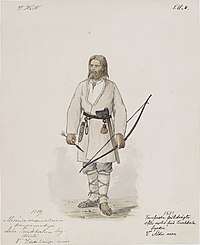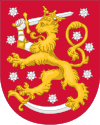Finns
Finns or Finnish people (Finnish: suomalaiset) are a Baltic Finnic ethnic group native to Finland.[39][40]
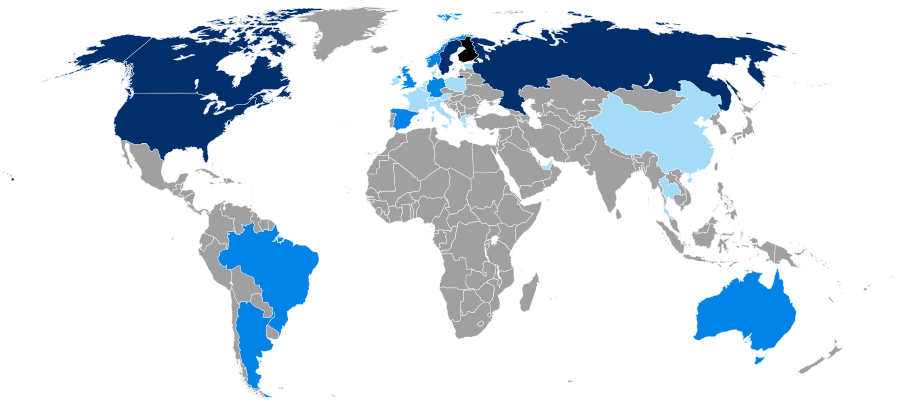 | |||||||||||||||||||||||||||||||
| Total population | |||||||||||||||||||||||||||||||
|---|---|---|---|---|---|---|---|---|---|---|---|---|---|---|---|---|---|---|---|---|---|---|---|---|---|---|---|---|---|---|---|
| c. 6.2–7 million[a] | |||||||||||||||||||||||||||||||
| Regions with significant populations | |||||||||||||||||||||||||||||||
| 649,761[5] | |||||||||||||||||||||||||||||||
| 156,045[6][c]–712,000[7][d] (including Tornedalians) | |||||||||||||||||||||||||||||||
| 143,645[8] | |||||||||||||||||||||||||||||||
| 127,600 (with all Karelians)[lower-alpha 1][9] 34,300 (with Ingrian Finns) | |||||||||||||||||||||||||||||||
| 30,359[10] | |||||||||||||||||||||||||||||||
| 16,000 (in 2002)[11] | |||||||||||||||||||||||||||||||
| 15,000–60,000 (including Forest Finns and Kvens)[12][13] | |||||||||||||||||||||||||||||||
| 15,000–30,000[14] | |||||||||||||||||||||||||||||||
| 12,961 (in 2016)[15] (up to 40,000 part-year residents)[16] | |||||||||||||||||||||||||||||||
| 8,260[17] | |||||||||||||||||||||||||||||||
| 6,000 (in 2005)[11] | |||||||||||||||||||||||||||||||
| 4,000[18] | |||||||||||||||||||||||||||||||
| 3,800[19] | |||||||||||||||||||||||||||||||
| 3,000[20] | |||||||||||||||||||||||||||||||
| 3,000[21] | |||||||||||||||||||||||||||||||
| 2,453 (in 2013)[22] | |||||||||||||||||||||||||||||||
| |||||||||||||||||||||||||||||||
| Languages | |||||||||||||||||||||||||||||||
| Finnish | |||||||||||||||||||||||||||||||
| Religion | |||||||||||||||||||||||||||||||
| Predominantly Lutheranism or irreligious, Eastern Orthodox minority[38] | |||||||||||||||||||||||||||||||
| Related ethnic groups | |||||||||||||||||||||||||||||||
| Other Baltic Finns (especially Forest Finns, Ingrian Finns and Tornedalians) | |||||||||||||||||||||||||||||||
a The total figure is merely a sum of all the referenced populations listed. b No official statistics are kept on ethnicity. However, statistics of the Finnish population according to first language and citizenship are documented and available. | |||||||||||||||||||||||||||||||
Finns are traditionally divided into smaller regional groups that span several countries adjacent to Finland, both those who are native to these countries as well as those who have resettled. Also, some of these may be classified as separate ethnic groups, rather than subgroups of Finns. These include the Kvens and Forest Finns in Norway, the Tornedalians in Sweden, and the Ingrian Finns in Russia.
Finnish, the language spoken by Finns, is closely related to other Balto-Finnic languages, e.g. Estonian and Karelian. The Finnic languages are a subgroup of the larger Uralic family of languages, which also includes Hungarian. These languages are markedly different from most other languages spoken in Europe, which belong to the Indo-European family of languages. Native Finns can also be divided according to dialect into subgroups sometimes called heimo (lit. tribe), although such divisions have become less important due to internal migration.
Today, there are approximately 6–7 million ethnic Finns and their descendants worldwide, with majority of them living in their native Finland and the surrounding countries, namely Sweden, Russia and Norway. An overseas Finnish diaspora has long been established in the countries of the Americas and Oceania, with the population of primarily immigrant background, namely Australia, Canada, New Zealand, Brazil and the United States.
Subgroups
The Population Register Centre maintains information on the birthplace, citizenship and mother tongue of the people living in Finland, but does not specifically categorize any as Finns by ethnicity.[41]
Balto-Finnic peoples
The majority of people living in Finland consider Finnish to be their first language. According to Statistics Finland, of the country's total population of 5,503,297 at the end of 2016, 88.3% (or 4,857,795) considered Finnish to be their native language.[42] It is not known how many of the ethnic Finns living outside Finland speak Finnish as their first language.
In addition to the Finnish-speaking inhabitants of Finland, the Kvens (people of Finnish descent in Norway), the Tornedalians (people of Finnish descent in northernmost Sweden), and the Karelians in the historic Finnish province of Karelia and Evangelical Lutheran Ingrian Finns (both in the northwestern Russian Federation), as well as Finnish expatriates in various countries, are Baltic Finns.
Finns have been traditionally divided into sub-groups (heimot in Finnish) along regional, dialectical or ethnographical lines. These subgroups include the people of Finland Proper (varsinaissuomalaiset), Satakunta (satakuntalaiset), Tavastia (hämäläiset), Savonia (savolaiset), Karelia (karjalaiset) and Ostrobothnia (pohjalaiset). These sub-groups express regional self-identity with varying frequency and significance.
There are a number of distinct dialects (murre s. murteet pl. in Finnish) of the Finnish language spoken in Finland, although the exclusive use of the standard Finnish (yleiskieli)—both in its formal written (kirjakieli) and more casual spoken (puhekieli) form—in Finnish schools, in the media, and in popular culture, along with internal migration and urbanization, have considerably diminished the use of regional varieties, especially since the middle of the 20th century. Historically, there were three dialects: the South-Western (Lounaismurteet), Tavastian (Hämeen murre), and Karelian (Karjalan murre). These and neighboring languages mixed with each other in various ways as the population spread out, and evolved into the Southern Ostrobothnian (Etelä-Pohjanmaan murre), Central Ostrobothnian (Keski-Pohjanmaan murre), Northern Ostrobothnian (Pohjois-Pohjanmaan murre), Far-Northern (Peräpohjolan murre), Savonian (Savon murre), and South-Eastern (Kaakkois-Suomen murteet) aka South Karelian (Karjalan murre) dialects.
Sweden Finns
The Sweden Finns are either native to Sweden or have emigrated from Finland to Sweden. An estimated 450,000 first- or second-generation immigrants from Finland live in Sweden, of which approximately half speak Finnish. The majority moved from Finland to Sweden following the Second World War, taking advantage of the rapidly expanding Swedish economy. This emigration peaked in 1970 and has been declining since. There is also a native Finnish-speaking minority in Sweden, the Tornedalians in the border area in the extreme north of Sweden. The Finnish language has official status as one of five minority languages in Sweden, but only in the five northernmost municipalities in Sweden.[43]
Other groups
The term Finns is also used for other Baltic Finns, including Izhorians in Ingria, Karelians in Karelia and Veps in the former Veps National Volost, all in Russia. Among these groups, the Karelians is the most populous one, followed by the Ingrians. According to a 2002 census, it was found that Ingrians also identify with Finnish ethnic identity, referring to themselves as Ingrian Finns.[44]
Terminology
The Finnish term for Finns is suomalaiset (sing. suomalainen).
It is a matter of debate how best to designate the Finnish-speakers of Sweden, all of whom have migrated to Sweden from Finland. Terms used include Sweden Finns and Finnish Swedes, with a distinction almost always made between more recent Finnish immigrants, most of whom have arrived after World War II, and Tornedalians, who have lived along what is now the Swedish-Finnish border since the 15th century.[45] The term "Finn" occasionally also has the meaning "a member of a people speaking Finnish or a Finnic language".[46][47]
Etymology
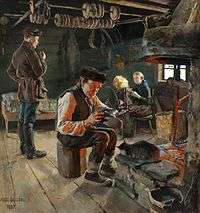
Historical references to Northern Europe are scarce, and the names given to its peoples and geographic regions are obscure; therefore, the etymologies of the names are questionable. Such names as Fenni, Phinnoi, Finnum, and Skrithfinni / Scridefinnum appear in a few written texts starting from about two millennia ago in association with peoples located in a northern part of Europe, but the real meaning of these terms is debatable. It has been suggested that this non-Uralic ethnonym is of Germanic language origin and related to such words as finthan (Old High German) 'find', 'notice'; fanthian (Old High German) 'check', 'try'; and fendo (Old High German) and vende (Old Middle German) 'pedestrian', 'wanderer'.[48] Another etymological interpretation associates this ethnonym with fen in a more toponymical approach. Yet another theory postulates that the words finn and kven are cognates. The Icelandic Eddas and Norse sagas (11th to 14th centuries), some of the oldest written sources probably originating from the closest proximity, use words like finnr and finnas inconsistently. However, most of the time they seem to mean northern dwellers with a mobile life style. An etymological link between the Sami and the Finns exists in modern Uralic languages as well. It has been proposed that e.g. the toponyms Sápmi (Sami for Lapland), Suomi (Finnish for Finland), and Häme (Finnish for Tavastia) are of the same origin,[48] the source of which might be related to the proto-Baltic word *žeme / Slavic земля (zemlja) meaning 'land'.[48] It has been proposed that these designations started to mean specifically people in Southwestern Finland (Finland Proper, Varsinais-Suomi) and later the whole area of modern Finland. But it is not known how, why, and when this occurred. Petri Kallio has suggested that the name Suomi may bear even earlier Indo-European echoes with the original meaning of either "land" or "human".[49]
The first known mention of Finns is in the Old English poem Widsith which was compiled in the 10th century, though its contents is probably older. Among the first written sources possibly designating western Finland as the land of Finns are also two rune stones. One of these is in Söderby, Sweden, with the inscription finlont (U 582), and the other is in Gotland, a Swedish island in the Baltic Sea, with the inscription finlandi (G 319 M) dating from the 11th century.[50]
History
With regard to the ancestry of the Finnish people, the modern view emphasizes the overall continuity in Finland's archeological finds[52] and (earlier more obvious) linguistic surroundings. Archeological data suggest the spreading of at least cultural influences from many sources ranging from the south-east to the south-west following gradual developments rather than clear-cut migrations.
Language
Just as uncertain are the possible mediators and the timelines for the development of the Uralic majority language of the Finns. On the basis of comparative linguistics, it has been suggested that the separation of the Finnic and the Sami languages took place during the 2nd millennium BC, and that the Proto-Uralic roots of the entire language group date from about the 6th to the 8th millennium BC. When the Uralic languages were first spoken in the area of contemporary Finland is debated. It is thought that Proto-Finnic (the proto-language of the Finnic languages) was not spoken in modern Finland, because the maximum divergence of the daughter languages occurs in modern-day Estonia. Therefore, Finnish was already a separate language when arriving in Finland. Furthermore, the traditional Finnish lexicon has a large number of words (about one-third) without a known etymology, hinting at the existence of a disappeared Paleo-European language; these include toponyms such as niemi "peninsula". Because the Finnish language itself reached a written form only in the 16th century, little primary data remains of early Finnish life. For example, the origins of such cultural icons as the sauna, the kantele (an instrument of the zither family), and the Kalevala (national epic) have remained rather obscure.
Livelihood
Agriculture supplemented by fishing and hunting has been the traditional livelihood among Finns. Slash-and-burn agriculture was practiced in the forest-covered east by Eastern Finns up to the 19th century. Agriculture, along with the language, distinguishes Finns from the Sami, who retained the hunter-gatherer lifestyle longer and moved to coastal fishing and reindeer herding. Following industrialization and modernization of Finland, most Finns were urbanized and employed in modern service and manufacturing occupations, with agriculture becoming a minor employer (see Economy of Finland).
Religion
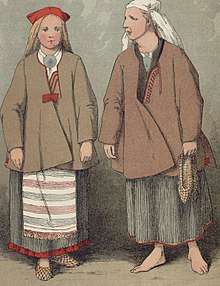
Christianity spread to Finland from the Medieval times onward and original native traditions of Finnish paganism have become extinct. Finnish paganism combined various layers of Finnic, Norse, Germanic and Baltic paganism. Finnic Jumala was some sort of sky-god and is shared with Estonia. Belief of a thunder-god, Ukko or Perkele, may have Baltic origins. Elements had their own protectors, such as Ahti for waterways and Tapio for forests. Local animistic deities, "haltia", which resemble Scandinavian tomte, were also given offerings to, and bear worship was also known. Finnish neopaganism or "suomenusko" attempts to revive these traditions.
Christianity was introduced to Finns and Karelians from the east, in the form of Eastern Orthodoxy from the Medieval times onwards. However, Swedish kings conquered western parts of Finland in the late 13th century, imposing Roman Catholicism. Reformation in Sweden had the important effect that bishop Mikael Agricola, a student of Martin Luther, introduced written Finnish, and literacy became common during the 18th century. When Finland became independent, it was overwhelmingly Lutheran Protestant. A small number of Eastern Orthodox Finns were also included, thus the Finnish government recognized both religions as "national religions". In 2017 70.9% of the population of Finland belonged to the Evangelical Lutheran Church of Finland, 1.1% to the Finnish Orthodox Church, 1.6% to other religious groups and 26.3% had no religious affiliation (see irreligion in Finland). Whereas, in Russian Ingria, there were both Lutheran and Orthodox Finns; the former were identified as Ingrian Finns while the latter were considered Izhorans or Karelians.
Subdivisions
Baltic Finns are traditionally assumed to originate from two different populations speaking different dialects of Proto-Finnic (kantasuomi). Thus, a division into West Finnish and East Finnish is made. Further, there are subgroups, traditionally called heimo,[53][54] according to dialects and local culture. Although ostensibly based on late Iron Age settlement patterns, the heimos have been constructed according to dialect during the rise of nationalism in the 19th century.
- Western[55]
- Häme: Tavastians or Häme people (hämäläiset)
- Ostrobothnia: Ostrobothnians (pohjalaiset)
- Southern Ostrobothnians (eteläpohjalaiset) have a particularly distinct identity and dialect
- Central Ostrobothnians (keskipohjalaiset)
- Northern Ostrobothnians (pohjoispohjalaiset)
- Norrbotten, Sweden: speakers of Meänkieli, a Far Northern dialect of Finnish
- Southwestern Finland: varsinaissuomalaiset
- Eastern
- Ingria: Ingrian Finns (inkerinsuomalaiset)
- Karelia: Karelian Finns (karjalaiset); Karelian dialects of Finnish are distinct from the Karelian language spoken in Russia, and most of Northern Karelia actually speak Savonian dialects
- Savo: Savonian people (savolaiset), speak the Savo dialect
- Emigrants
- Forest Finns (Metsäsuomalaiset) of Sweden
- Finnish immigrants to Sweden (ruotsinsuomalaiset)
- Kvens (kveenit) of Finnmark, Norway
- Other emigrant Finns (ulkosuomalaiset)
The historical provinces of Finland can be seen to approximate some of these divisions. The regions of Finland, another remnant of a past governing system, can be seen to reflect a further manifestation of a local identity.
Today's (urbanized) Finns are not usually aware of the concept of 'heimo' nor do they typically identify with one (except maybe Southern Ostrobothnians), although the use of dialects has experienced a recent revival. Urbanized Finns do not necessarily know a particular dialect and tend to use standard Finnish or city slang but they may switch to a dialect when visiting their native area.
Genetics
Recently, the use of mitochondrial "mtDNA" (female lineage) and Y-chromosomal "Y-DNA" (male lineage) DNA-markers in tracing back the history of human populations has been started. For the paternal and maternal genetic lineages of Finnish people and other peoples, see, e.g., the National Geographic Genographic Project[56] and the Suomi DNA-projekti. Haplogroup U5 is estimated to be the oldest major mtDNA haplogroup in Europe and is found in the whole of Europe at a low frequency, but seems to be found in significantly higher levels among Finns, Estonians and the Sami people.[56] The original European hunter-gatherers that populated large parts of Europe before the early farmers appeared are outside the genetic variation of modern populations, but most similar to Finnish individuals.[57]
With regard to the Y-chromosome, the most common haplogroups of the Finns are N1c (59%), I1a (28%), R1a (5%) and R1b (3.5%).[58] Haplogroup N1c, which is found mainly in a few countries in Europe (Latvia, Lithuania, Estonia, Finland, Russia), is a subgroup of the haplogroup N (Y-DNA) distributed across northern Eurasia and estimated to have entered Europe from Asia.[59]
Variation within Finns is, according to fixation index (FST) values, greater than anywhere else in Europe. Greatest intra-Finnish FST distance is found about 60, greatest intra-Swedish FST distance about 25.[60][61] FST distances between for example Germans, French and Hungarians is only 10, and between Estonians, Russians and Poles it is also 10.[62] Thus Finns from different parts of the country are more remote from each other genetically compared to many European peoples between themselves.[63] The closest genetic relatives for Finns are Estonians (FST to Helsinki 40 and to Kuusamo 90) and Swedes (FST to Helsinki 50 and to Kuusamo 100). The FST values given here are actual values multiplied by 10,000. The great intra-Finnish (FST) distance between Western Finns and Eastern Finns[60][61] supports the theorized dual origin of the Finns[64] based on the regional distribution of the two major Y-DNA haplogroups, N1c in Eastern Finland and I1a in Western Finland.[58]
Finns show very little if any Mediterranean and African genes but on the other hand almost 10% of Finnish genes seem to be shared with Siberian populations. Nevertheless, more than 80% of Finnish genes are from a single ancient Northeastern European population, while most Europeans are a mixture of 3 or more principal components.[65] Most male Finns belong to the Y-DNA Haplogroup N (M231). It is generally considered that N-M231 arose in East Asia approximately 19,400 (±4,800) years ago and re-populated northern Eurasia after the Last Glacial Maximum. Males carrying the marker apparently moved northwards as the climate warmed in the Holocene, migrating in a counter-clockwise path (through modern China and Mongolia), to eventually become concentrated in areas as far away as Fennoscandia and the Baltic.[66] The apparent death of haplogroup N-M231 amongst Native American peoples indicates that it spread after Beringia was submerged,[67] about 11,000 years ago. Most samples from the Liao civilization in northeastern China and northern Korea belonged to y-DNA N. N has been found in many samples of Neolithic human remains exhumed from northeastern China and the circum-Baikal area of southern Siberia. It is thus suggested that the ancestors of the Uralic-peoples and of the Turkic-Yakut peoples may have originated in this region about 8000-6000 years ago.[68]
Theories of the origins of ethnic Finns
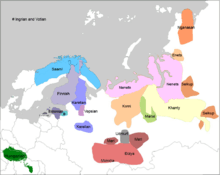
In the 19th century, the Finnish researcher Matthias Castrén prevailed with the theory that "the original home of Finns" was in west-central Siberia.[69]
Until the 1970s, most linguists believed that Finns arrived in Finland as late as the first century AD. However, accumulating archaeological data suggests that the area of contemporary Finland had been inhabited continuously since the end of the ice age, contrary to the earlier idea that the area had experienced long uninhabited intervals. The hunter-gatherer Sami were pushed into the more remote northern regions.[70]
A hugely controversial theory is so-called refugia. This was proposed in the 1990s by Kalevi Wiik, a professor emeritus of phonetics at the University of Turku. According to this theory, Finno-Ugric speakers spread north as the Ice age ended. They populated central and northern Europe, while Basque speakers populated western Europe. As agriculture spread from the southeast into Europe, the Indo-European languages spread among the hunter-gatherers. In this process, both the hunter-gatherers speaking Finno-Ugric and those speaking Basque learned how to cultivate land and became Indo-Europeanized. According to Wiik, this is how the Celtic, Germanic, Slavic, and Baltic languages were formed. The linguistic ancestors of modern Finns did not switch their language due to their isolated location.[71] The main supporters of Wiik's theory are Professor Ago Künnap of the University of Tartu, Professor Kyösti Julku of the University of Oulu and Associate Professor Angela Marcantonio of the University of Rome. Wiik has not presented his theories in peer-reviewed scientific publications. Many scholars in Finno-Ugrian studies have strongly criticized the theory. Professor Raimo Anttila, Petri Kallio and brothers Ante and Aslak Aikio have renounced Wiik's theory with strong words, hinting strongly to pseudoscience and even at right-wing political biases among Wiik's supporters.[70][72] Moreover, some dismissed the entire idea of refugia, due to the existence even today of arctic and subarctic peoples. The most heated debate took place in the Finnish journal Kaltio during autumn 2002. Since then, the debate has calmed, each side retaining their positions.[73] While the refugium theory proved unpopular among Finns, substantial genotype analyses across the greater European genetic landscape have mostly confirmed the Last Glacial Maximum refugiums to be correct and have substantial backing of the greater scientific community.[74][75][76][77][78]
See also
- Demographics of Finland
- Finnic (disambiguation)
- Finnish (disambiguation)
- Finnish language
- Finnish Americans
- Finnish Canadians
- Finnish Australians
- Finnish immigration to North America
- List of Finns
Notes
- Karelians are generally considered to be a closely related but separate ethnic group from Finns rather than a regional subgroup, with their language and ethnic identity.
References
- "Population". Statistics Finland. Retrieved 3 May 2016.
Persons with Finnish background: 5,115,300
Native Finnish speakers: 4,778,490 - "Suomen ennakkoväkiluku tammikuun lopussa 5 402 758" [Finnish preliminary population by the end of January stood at 5,402,758] (in Finnish). Statistics Finland. Retrieved 17 March 2015.
- "Preliminary population statistics". Statistics Finland. 17 March 2014. Retrieved 24 February 2015.
- "The World Factbook – Finland". Central Intelligence Agency. Retrieved 29 February 2016.
Finns 93.4%, Swede 5.6%, other 1% (2006).
- "Table B04006 - People Reporting Ancestry - 2018 American Community Survey 1-Year Estimates". United States Census Bureau. Retrieved 23 July 2020.
- "Foreign-born persons by country of birth and year". Statistics Sweden. Archived from the original on 5 March 2016. Retrieved 24 February 2016.
- "Fler med finsk bakgrund i Sverige" [Number of people with Finnish background in Sweden is rising] (in Swedish). 22 February 2013. Retrieved 24 February 2016.
- Statistics Canada. "Immigration and Ethnocultural Diversity Highlight Tables". Retrieved 1 June 2016.
- № 689-690 - Национальный состав населения России по данным переписей населения (тысяч человек) [№ 689-690 - Ethnic composition of the population of Russia according to census data (in thousands of people)] (in Russian). Demoscope Weekly. 30 June 2016. Retrieved 5 July 2016.
- Australian Government - Department of Immigration and Border Protection. "Finnish Australians". Archived from the original on 16 January 2014. Retrieved 16 January 2014.
- Euroopassa asuneet Suomen kansalaiset maittain 1971-2002. Retrieved 11-21-2007. (in Finnish) Archived 28 August 2004 at the Wayback Machine
- regionaldepartementet, Kommunal- og (8 December 2000). "St.meld. nr. 15 (2000-2001)". Regjeringa.no.
- Saressalo, L. (1996), Kveenit. Tutkimus erään pohjoisnorjalaisen vähemmistön identiteetistä. Suomalaisen Kirjallisuuden Seuran Toimituksia, 638. Helsinki.
- "Kahdesta miljoonasta ulkosuomalaisesta suuri osa on "kateissa" – Ulkomailla asuvat ovat aina poikkeama tilastoissa" (in Finnish). YLE. Retrieved 26 February 2018.
- "Kahdenväliset suhteet" (in Finnish). Embassy of Finland, Madrid. Retrieved 26 February 2018.
- "Paljonko suomalaisia asuu Espanjassa?" (in Finnish). Suomi-Espanja Seura. Archived from the original on 27 February 2018. Retrieved 26 February 2018.
- "Suomi Virossa" (in Finnish). Embassy of Finland, Tallinn. Retrieved 26 February 2018.
- "Kahdenväliset suhteet" (in Finnish). Embassy of Finland, Rome. Retrieved 26 February 2018.
- "Suomi Sveitsissä" (in Finnish). Embassy of Finland, Bern. Retrieved 26 February 2018.
- "Kahdenväliset suhteet" (in Finnish). Embassy of Finland, Copenhagen. Retrieved 26 February 2018.
- "Kahdenväliset suhteet" (in Finnish). Embassy of Finland, Brussels. Retrieved 26 February 2018.
- "Kahdenväliset suhteet" (in Finnish). Embassy of Finland, The Hague. Retrieved 26 February 2018.
- "Kahdenväliset suhteet" (in Finnish). Embassy of Finland, Athens. Retrieved 26 February 2018.
- "Maatiedosto Thaimaa" (in Finnish). Embassy of Finland, Bangkok. Retrieved 26 February 2018.
- "Kahdenväliset suhteet" (in Finnish). Embassy - Embassy of Finland, Abu Dhabi. Retrieved 26 February 2018.
- "Kahdenväliset suhteet" (in Finnish). Embassy of Finland, Beijing. Retrieved 26 February 2018.
- "Kahdenväliset suhteet" (in Finnish). Consulate General of Finland, Hong Kong. Retrieved 26 February 2018.
- "Embassy - Embassy of Finland, Dublin". Retrieved 26 February 2018.
- "Suomi Itävallassa" (in Finnish). Embassy of Finland, Vienna. Retrieved 26 February 2018.
- "Suomalaiset Puolassa" (in Finnish). Embassy of Finland, Warsaw. Retrieved 26 February 2018.
- "Suomi Portugalissa" (in Finnish). Embassy of Finland, Lisbon. Retrieved 26 February 2018.
- "Suomi Israelissa" (in Finnish). Embassy of Finland, Tel Aviv. Retrieved 26 February 2018.
- "Kahdenväliset suhteet" (in Finnish). Embassy of Finland, Singapore. Retrieved 26 February 2018.
- "Suomi Japanissa" (in Finnish). Embassy of Finland, Tokyo. Retrieved 26 February 2018.
- "Suomi Brasiliassa" (in Finnish). Embassy of Finland, Brasília. Retrieved 26 February 2018.
- "2013 Census ethnic group profiles". Stats.govt.nz. Retrieved 25 December 2017.
- "Suomi Brasiliassa" (in Finnish). Embassy of Finland, Nicosia. Retrieved 26 February 2018.
- "Population". Statistics Finland. Retrieved 3 May 2016.
- "Finn noun" The Oxford Dictionary of English (revised edition). Ed. Catherine Soanes and Angus Stevenson. Oxford University Press, 2005. Oxford Reference Online. Oxford University Press. Tampere University of Technology. 3 August 2007
- Anne Ollila (1 September 1998). "Perspectives to Finnish Identity". Scandinavian Journal of History. 23 (3–4): 127–137. doi:10.1080/03468759850115918.
- Rapo, Markus. "Tilastokeskus - Suomen väestö 2006". Tilastokeskus.fi. Retrieved 25 December 2017.
- "PX-Web - Valitse taulukko". pxnet2.stat.fi. Retrieved 1 August 2017.
- "Kultur & Fritid". Kultur.stockholm.se. Retrieved 17 March 2015.
- "Êîìè íàðîä / Ôèííî-óãðû / Íàðîäû / Ôèííû-èíãåðìàíëàíäöû". Kominarod.ru. Archived from the original on 16 February 2015. Retrieved 17 March 2015.
- "Traditionally, immigrants were described in English and most other languages by an adjective indicating the new country of residence and a noun indicating their country of origin or their ethnic group. The term "Sweden Finns" corresponds to this naming method. Immigrants to the U.S. have, however, always been designated the "other way around" by an adjective indicating the ethnic or national origin and a noun indicating the new country of residence, for example "Finnish Americans" (never "American Finns"). The term "Finnish Swedes" corresponds to this more modern naming method that is increasingly used in most countries and languages because it emphasises the status as full and equal citizens of the new country while providing information about cultural roots. (For more information about these different naming methods see Swedish-speaking Finns.) Other possible modern terms are "Finnish ethnic minority in Sweden" and "Finnish immigrants". These may be preferable because they make a clear distinction between these two very different population groups for which use of a single term is questionable and because "Finnish Swedes" is often used like "Finland Swedes" to mean "Swedish-speaking Finns". It should perhaps also be pointed out that many Finnish and Swedish speakers are unaware that the English word "Finn" elsewhere than in this article usually means "a native or inhabitant of Finland" ("Finn". American Heritage Dictionary. 2000. Archived from the original on 27 October 2007 – via Bartleby.com.
- "Finn". Concise Oxford English Dictionary. Oxford Dictionaries.
- "Finn". Encarta Dictionary. MSN. Archived from the original on 11 December 2008.
- "Suomalais-Ugrilainen Seura". Sgr.fi. Retrieved 17 March 2015.
- Kallio, Petri 1998: Suomi(ttavia etymologioita) – Virittäjä 4 / 1998.
- "vanhempi mies "muinaissuomalaisessa kansanpuvussa" Mikkelin Tuukkalan löytöjen mukaan". www.finna.fi. Retrieved 3 January 2020.
- "Origin of Finnish and related languages - thisisFINLAND: Facts: Education & research". 16 July 2011. Archived from the original on 16 July 2011. Retrieved 25 December 2017.
- Heimo is often mistranslated as "tribe", but a heimo is a dialectal and cultural kinship rather than a genetic kinship, and represents a much larger and disassociated group of people. Suomalaiset heimot. From the book Hänninen, K. Kansakoulun maantieto ja kotiseutuoppi yksiopettajaisia kouluja varten. Osakeyhtiö Valistus, Raittiuskansan Kirjapaino Oy, Helsinki 1929, neljäs painos. The excerpt from a 1929 school book shows the generalized concept. Retrieved 1-13-2008. (in Finnish)
- Sedergren, J (2002) Evakko – elokuva ja romaani karjalaispakolaisista. Ennen & nyt 3/2002. Retrieved 1-13-2008. (in Finnish) The reference is a movie review, which however discusses the cultural phenomenon of the evacuation of Finnish Karelia using and analyzing the heimo concept rather generally.
- Topelius, Z. (1876) Maamme kirja. Lukukirja alimmaisille oppilaitoksille Suomessa. Toinen jakso. Suom. Johannes Bäckvall. (in Finnish) Retrieved 13-1-2008. (in Finnish) Pp. 187 onwards shows the stereotypical generalizations of the heimos listed here.
- "Atlas of the Human Journey - The Genographic Project". 5 April 2008. Archived from the original on 5 April 2008.CS1 maint: BOT: original-url status unknown (link)
- "Science: Stone Age Skeletons Suggest Europe's First Farmers Came From Southern Europe". AAAS - The World's Largest General Scientific Society. 26 April 2012. Retrieved 8 August 2017.
- Lappalainen, T; Koivumäki, S; Salmela, E; Huoponen, K; Sistonen, P; Savontaus, M. L.; Lahermo, P (2006). "Regional differences among the Finns: A Y-chromosomal perspective". Gene. 376 (2): 207–15. doi:10.1016/j.gene.2006.03.004. PMID 16644145.
- Rootsi, Siiri; Zhivotovsky, Lev A; Baldovič, Marian; Kayser, Manfred; Kutuev, Ildus A; Khusainova, Rita; Bermisheva, Marina A; Gubina, Marina; Fedorova, Sardana A; Ilumäe, Anne-Mai; Khusnutdinova, Elza K; Voevoda, Mikhail I; Osipova, Ludmila P; Stoneking, Mark; Lin, Alice A; Ferak, Vladimir; Parik, Jüri; Kivisild, Toomas; Underhill, Peter A; Villems, Richard (2007). "A counter-clockwise northern route of the Y-chromosome haplogroup N from Southeast Asia towards Europe". European Journal of Human Genetics. 15 (2): 204–211. doi:10.1038/sj.ejhg.5201748. ISSN 1018-4813. PMID 17149388.
- Salmela; et al. (2011). "Swedish Population Substructure Revealed by Genome-Wide Single Nucleotide Polymorphism Data". PLoS ONE. 6 (2): e16747. Bibcode:2011PLoSO...616747S. doi:10.1371/journal.pone.0016747. PMC 3036708. PMID 21347369.
- Jakkula; et al. (2008). "The Genome-wide Patterns of Variation Expose Significant Substructure in a Founder Population". The American Journal of Human Genetics. 83 (6): 787–794. doi:10.1016/j.ajhg.2008.11.005. PMC 2668058. PMID 19061986.
- Nelis; et al. (2009). "Genetic Structure of Europeans: A View from the North-East". PLoS ONE. 4 (5): e5472. Bibcode:2009PLoSO...4.5472N. doi:10.1371/journal.pone.0005472. PMC 2675054. PMID 19424496.
- Häkkinen, Jaakko (2011). "Seven Finnish populations: the greatest intranational substructure in Europe". Archived from the original on 27 September 2011. Retrieved 17 August 2011.
- Kittles, R. A; Perola, M; Peltonen, L; Bergen, A. W.; Aragon, R. A.; Virkkunen, M; Linnoila, M; Goldman, D; Long, J. C. (1998). "Dual Origins of Finns Revealed by Y Chromosome Haplotype Variation". The American Journal of Human Genetics. 62 (5): 1171–1179. doi:10.1086/301831. PMC 1377088. PMID 9545401.
- "Haplogroup N1c (Y-DNA)". Eupedia. 14 April 2013. Retrieved 30 November 2017.
- Rootsi 2006.
- Chiaroni 2009.
- Cui, Yinqiu; Li, Hongjie; Ning, Chao; Zhang, Ye; Chen, Lu; Zhao, Xin; Hagelberg, Erika; Zhou, Hui (30 September 2013). "Y Chromosome analysis of prehistoric human populations in the West Liao River Valley, Northeast China". BMC Evolutionary Biology. 13 (1): 216. doi:10.1186/1471-2148-13-216. ISSN 1471-2148. PMC 3850526. PMID 24079706.
- (in Finnish) Lehikoinen, L. (1986) D.E.D Europaeus kirjasuomen kehittäjänä ja tutkijana. Virittäjä, 1986, 178–202. with German abstract. Retrieved 1-8-2008.
- Aikio, A & Aikio, A. (2001). Heimovaelluksista jatkuvuuteen – suomalaisen väestöhistorian tutkimuksen pirstoutuminen. Muinaistutkija 4/2001. (in Finnish) Retrieved 1-7-2008 Archived 27 February 2008 at the Wayback Machine
- "Kaltio - Pohjoinen kulttuurilehti - Uusin kaltio". Kaltio.fi. Retrieved 17 March 2015.
- "Kaltio - Pohjoinen kulttuurilehti - Uusin kaltio". Kaltio.fi. Retrieved 17 March 2015.
- The debate (in Finnish) is accessible in Kaltio's website. Retrieved 1-7-2008.
- Semino O, Passarino G, Oefner PJ, Lin AA, Arbuzova S, Beckman LE, De Benedictis G, Francalacci P, Kouvatsi A, Limborska S, Marcikiae M, Mika A, Mika B, Primorac D, Santachiara-Benerecetti AS, Cavalli-Sforza LL, Underhill PA (10 November 2000). "The genetic legacy of Paleolithic Homo sapiens sapiens in extant Europeans: a Y chromosome perspective". Science. 290 (5494): 1155–9. Bibcode:2000Sci...290.1155S. doi:10.1126/science.290.5494.1155. PMID 11073453.
- Malaspina P, Cruciani F, Santolamazza P, Torroni A, Pangrazio A, Akar N, Bakalli V, Brdicka R, Jaruzelska J, Kozlov A, Malyarchuk B, Mehdi SQ, Michalodimitrakis E, Varesi L, Memmi MM, Vona G, Villems R, Parik J, Romano V, Stefan M, Stenico M, Terrenato L, Novelletto A, Scozzari R (September 2000). "Patterns of male-specific inter-population divergence in Europe, West Asia and North Africa" (PDF). Ann Hum Genet. 64(Pt 5): 395–412.
- Torroni, Antonio, Hans-Jürgen Bandelt, Vincent Macaulay, Martin Richards, Fulvio Cruciani, Chiara Rengo, Vicente Martinez-Cabrera et al. (2001). "A signal, from human mtDNA, of postglacial recolonization in Europe". American Journal of Human Genetics. 69 (4): 844–52. doi:10.1086/323485. PMC 1226069. PMID 11517423.CS1 maint: uses authors parameter (link)
- Achilli, Alessandro, Chiara Rengo, Chiara Magri, Vincenza Battaglia, Anna Olivieri, Rosaria Scozzari, Fulvio Cruciani et al. (2004). "The molecular dissection of mtDNA haplogroup H confirms that the Franco-Cantabrian glacial refuge was a major source for the European gene pool". The American Journal of Human Genetics. 75 (5): 910–918. doi:10.1086/425590. PMC 1182122. PMID 15382008.CS1 maint: uses authors parameter (link)
- Pala, Maria, Anna Olivieri, Alessandro Achilli, Matteo Accetturo, Ene Metspalu, Maere Reidla, Erika Tamm et al. (2012). "Mitochondrial DNA Signals of Late Glacial Recolonization of Europe from Near Eastern Refugia". The American Journal of Human Genetics. 90 (5): 915–924. doi:10.1016/j.ajhg.2012.04.003. PMC 3376494. PMID 22560092.CS1 maint: uses authors parameter (link)
External links
| Wikiquote has quotations related to: Finns |
![]()
